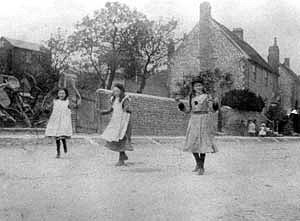Steyning Museum - Memories from Childhood
From the Steyning Museum archivesMemories from Childhood

Letters recalling the past very often roam and lurch unpredictably from one memory to another. Read them carefully though and there are gems to be found.
A letter from Jinny whose family, the Howards, lived at Wappingthorne House is a case in point. She was explaining that her family had been moved out of the main house during the last War to make room for troops training locally. She went on - 'I believe that the first battalion to move into the house came from the Royal Scots Fusiliers Regiment from Glasgow, who not only broke into the wine cellar, but also the wood store - but I think that the winter after Dunkirk was a very cold one, so perhaps they had reason. I remember this very clearly because I fell deeply in love with a dark haired lad called Joe, and nagged my family for all their left over bits of wool, to knit him a scarf. My knitting skills were not very good at the age of six, but I persevered for many years and the scarf got longer and longer - but was a very weird shape because it was made up of all different thicknesses and shades of khaki.'
Ellen Rapley tells us of rather greater success with her needlework. When very young in the 1870's she went to a 'Dame' school - a sort of pre-school. There her teacher was Miss Tolley who had only one arm. Even so she managed to teach Ellen how to sew - 'She would put the material on the stump of her left arm and successfully tack and sew'. Ellen's memories range far and wide. For instance, in January 1881, when heavy snow fell, the Town Crier had to be sent out to let people know that they should still send their children to school. But it is the small things which say most about her childhood. She played in the High Street with her hoop and, in her old age, still remembered the smell and feel of wood shavings on the floor of her father's carpentry shop.
Some of the memories recall customs which are long gone. Edith Carew, as a child in the 1880's, tells us of the events of May Day. Children would go from house to house with garlands of wild spring flowers chanting 'A Penny to see my Garland'. But her recollections of St. Valentine's Day evoke more recent traditions - 'The first person of the opposite sex that you saw that morning' she says 'was your Valentine for the year and my nurse and I tried very hard to see the postman first - although I could not quite understand why my friend the milkman would not do as well: I have wondered since whether it was because he was already married'.
Many of Edith's memories reflect the fact that Steyning was still essentially a rural community and children lived outside a good deal. She played in the hayfields and rode on the top of the load as the wagons went back to the rick in the farmyard. One wagoner, as he returned to the fields, would get his team of horses to trot through rutted gateways so that the children 'were thrown about over the floor of the wagon. We simply loved it and shrieked with delight.'
A poem by Charles Dalmon is itself like a letter recalling how, as a child, he roamed over the Downs in the company of a young friend. Three of the verses show how much and how little has changed.
We used to have a racing game with scores of knob-horned snails
Or climb to where red squirrels skipped and swished their bushy tails
Or stand near stacks at threshing time on any sort of day
To see the rats and mice jump out and scoot to get away
And after turns at 'horney', 'touch', leap-frog', or 'ducks-and-drakes'
We shared each other's 'fleedy rolls' or hunks of raisin cakes
A gem indeed. But what on earth was a 'fleedy roll'?

